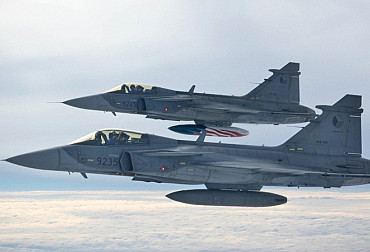The Military Technical Institute Wants to Develop an Anti-drone Laser Gun
In recent years, the Military Technical Institute (MTI) has introduced ammunition for under-barrel grenade launchers, which was intended for the destruction of drones. The 1.5 x 1.5 meter net was supposed to paralyse the drone, and the subsequent fall would mean the destruction or decommissioning for the drone. Now the MTI wants to replace the anti-drone ammunition with modern technology, which will be worked on for several years to follow.

Picture: Now the MTI wants to replace the anti-drone ammunition with modern technology, which will be worked on for several years to follow. (illustration photo) | Shutterstock
“In the branch plant in Slavičín, we developed our own anti-drone ammunition for an under-barrel grenade launcher. After firing, it disintegrates into a net and is able to capture the rotor drone,” described director of MTI Jiří Protiva for the Český Rozhlas in 2018, adding that this is a military solution that is not suitable for housing or other inhabited areas. This information, including a demonstration of a disintegrated missile, could be seen on the MTI Facebook page already a year before that interview. If we take into account the possibilities of aiming the under-barrel grenade launcher, range, but also the speed of the moving drone (commercial drones usually reach speeds of around 60 km/h), we can seriously doubt the real effect. Even if it was a drone that only “hanged” in the air motionless, at a relatively small height, the purpose of this ammunition is debatable, and so is the expenditure on the development of the ammunition.
We are now approaching the end of 2020 and the MTI has recently made another statement. “One of the main trends that the MTI wants to focus on is the use of laser technologies in the military. We want to cooperate with the Czech Academy of Sciences and its professional institutes. The common intention is to develop a so-called laser gun, which would be used to destroy drones with a laser beam. The project wants to use a special laser technology, which the Academy of Sciences developed as the one and only institute in the world," says Protiva. The statement further reads: “We can be among the leaders in the world,” which suggests great hopes in the development and overall cooperation of the state enterprise with the Academy of Sciences. However, the project is estimated to be completed in several of years, and if at the end of 2020 there is talk of several years of development in such a dynamic area, the above statement seems quite bold.
Although we do not yet know the exact parameters and uniqueness of the Czech system, we can look at the overall development of laser systems in the world. For example, China reported on the successful development of a laser system that can destroy targets at a distance of two kilometers (and an even longer range is expected) as early as 2014.
Of course, America is not falling behind, and already in 2016, the MEHEL 2.0 (Mobile High-Energy Laser) system was being developed and partly deployed in operation of the Stryker armoured wheeled vehicle with the possibility of installation on other, much smaller, platforms such as off-road buggies. “The army already has a 10kW laser at its disposal, and in the fiscal year 2018 it will start testing a laser five times stronger. By 2022, the military could test a 100kW laser. It could then be part of the missile defence system, said the head of the US Space Command and Missile Defence James Dickinson in 2017. The development of the USA is therefore constantly advancing in this direction and introduces increasingly efficient systems.
Israel is also not falling behind either, and for example in 2018, it was announced that the anti-drone system Israeli Multi-Mission Hemispheric Radars (MHR) from RADA Electronic Industries (this system is part of the Rafael Advanced Defense Systems Drone Dome) will be used by the British military. The Drone Dome is able to use its powerful radar to identify and subsequently deactivate the UAS (Unmanned aircraft system) within a two-second focus of a 5kW laser with a range of up to 2 kilometers.
The question therefore remains to what extent the Czech laser technology, which will be developed in cooperation with MTI and the Czech Academy of Sciences in the years to come, will be unique and effective compared to global competition, and how much will be invested in total.





















